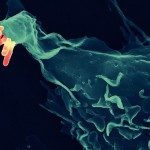Lien vers Pubmed [PMID] – 36061869
Lien DOI – 10.3389/fcimb.2022.989451
Front Cell Infect Microbiol 2022 ; 12(): 989451
Salmonella enterica is capable of invading different host cell types including epithelial cells and M cells during local infection, and immune cells and fibroblasts during the subsequent systemic spread. The intracellular lifestyles of Salmonella inside different cell types are remarkable for their distinct residential niches, and their varying replication rates. To study this, researchers have employed different cell models, such as various epithelial cells, immune cells, and fibroblasts. In epithelial cells, S. Typhimurium dwells within modified endolysosomes or gains access to the host cytoplasm. In the cytoplasm, the pathogen is exposed to the host autophagy machinery or poised for rapid multiplication, whereas it grows at a slower rate or remains dormant within the endomembrane-bound compartments. The swift bimodal lifestyle is not observed in fibroblasts and immune cells, and it emerges that these cells handle intracellular S. Typhimurium through different clearance machineries. Moreover, in these cell types S. Typhimurium grows withing modified phagosomes of distinct functional composition by adopting targeted molecular countermeasures. The preference for one or the other intracellular niche and the diverse cell type-specific Salmonella lifestyles are determined by the complex interactions between a myriad of bacterial effectors and host factors. It is important to understand how this communication is differentially regulated dependent on the host cell type and on the distinct intracellular growth rate. To support the efforts in deciphering Salmonella invasion across the different infection models, we provide a systematic comparison of the findings yielded from cell culture models. We also outline the future directions towards a better understanding of these differential Salmonella intracellular lifestyles.

